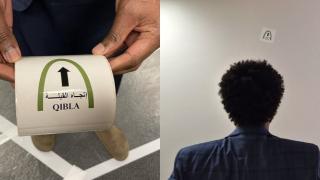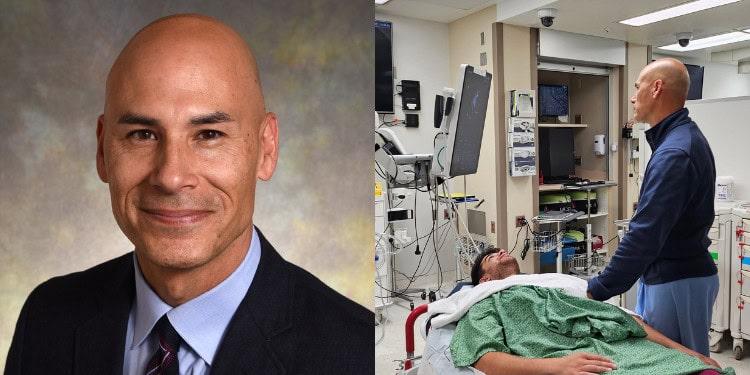
The emergency department of Hennepin Healthcare is one of the busiest in Minnesota. In one of the most active parts of the ED, where the patients are arriving from the ambulances, Thomas Wyatt, MD, FACEP, joins his fellow team members in a huddle to discuss care plans for patients awaiting treatment. They continue their discussions on a walk down the hall to greet their patients.
"I come to work every day not knowing what to expect because it's never going to be the same day ever as an emergency physician," says Dr. Wyatt.
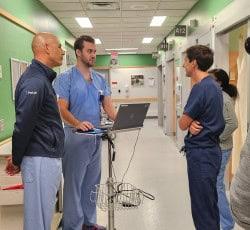
Appointed as the new Chair of the Department of Emergency Medicine at Hennepin Healthcare, Dr. Wyatt completed his Emergency Medicine Residency here at Hennepin in 2003 and began serving as a faculty emergency medicine physician in 2011. Dr. Wyatt is also an Associate Professor of Emergency Medicine at the University of Minnesota Medical School.
He is one of the first tribally enrolled American Indians (Shawnee/Quapaw) to lead an academic emergency department in the United States – and the first to chair an emergency department in Minnesota.
We sat down with Dr. Wyatt to discuss this historic appointment and how his identity as American Indian inspires his work.
You served on the Hennepin Healthcare board for six years and are currently one of the co-chairs of the Hennepin Healthcare American Indian Collective. How have these positions shaped you, and how you bring yourself here as a provider and with team members?
"I think lived experience, in general, is significant and something you should not be afraid to bring into an organization. For me – as someone who identifies as an American Indian, someone who's underrepresented in society – I think it's important to show up and be present in leadership roles whenever I can. It's important to serve as an example to other American Indians and American Indian youth who might want to pursue a career path like mine. And it's just being open to being a lifelong learner and experiencing other cultures, people, and ways of learning. It's been important for me and my development."
What are some reasons you give your time to the Collective – why do you think it's important to the team?
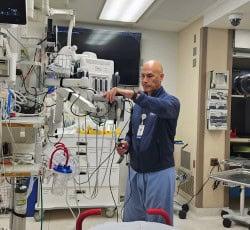
"I think it's important because it lets us get to know one another. The collective creates space for us to interact and share our traditions and cultural beliefs and really to try to educate and raise awareness for others in the institution who do not identify as American Indian about our culture and our history. One of the things that we've decided to do as an American Indian Collective is trying to engage with our local American Indian communities in outreach to let them know that we are here at Hennepin, and about the work that we do, and how we may be of support to them or assistance to them as their community members."
You've spoken at our American Indian Youth with Stethoscopes Youth Summit – an event that introduces youth ages 12-18 to careers in healthcare. Do you have any words or advice for young people who want to pursue medicine, especially American Indian youth or other youth who are historically excluded from careers in healthcare?
"Interacting with American Indian youth, especially those interested in a healthcare career, fills my cup and reenergizes me. It helps me to focus on my purpose. I was attracted to working with American Indian Youth with Stethoscopes because I didn't have anything like that growing up. There aren't a lot of American Indian healthcare professionals; you don't really see that whenever you go to the hospital or the clinic to get your care.
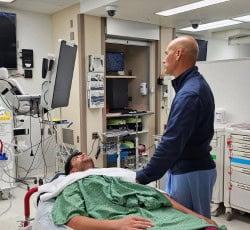
I didn't know I wanted to be a doctor until later in my academic career. I hope to pass the torch to the next generation, allowing them to see me as an example of someone who worked hard and developed into a professional. It wasn't always an easy road for me. There are obstacles along the way, but there are people who want to support you and see you succeed. There are a lot of mentors out there. Mentoring is another theme I think you'll hear that's common in Indian country. And if I can somehow pass that along as well, being a good mentor and an example to our youth as others did for me, that's perhaps the most important thing I can do."
Coming from a community that is marginalized by the system and society, how do you exist and settle yourself in the space?
"That's a really good question. I think it's important to try to look for systems and organizations that are supportive of those of us who are underrepresented in society, such as American Indians. Again, I think showing up every day and being your authentic self as much as you can is important, as well as not shying away from difficult interactions you might have with others trying to learn more about your culture.
At Hennepin we serve a very diverse patient population. Among those are American Indians. We know that American Indians have endured a lot of historical trauma. A lot of that trauma points to why there are so many health disparities that exist today among American Indians in this country."


